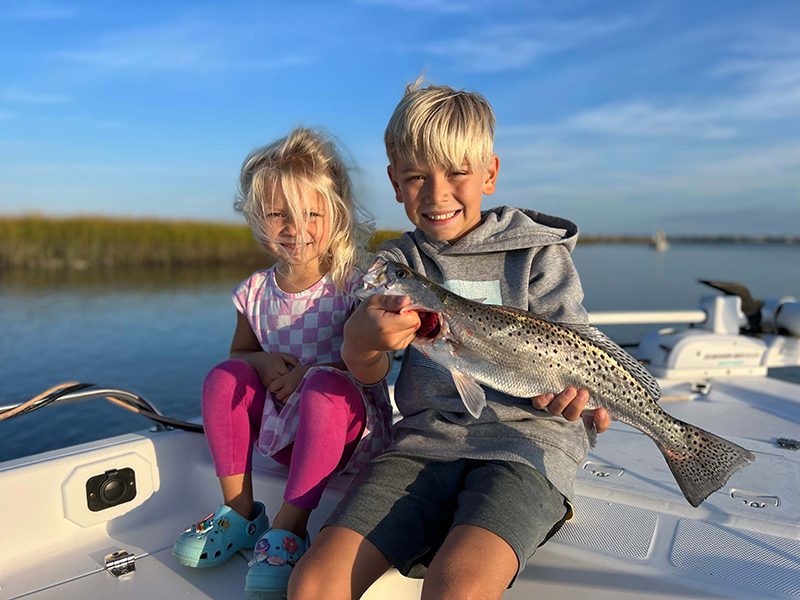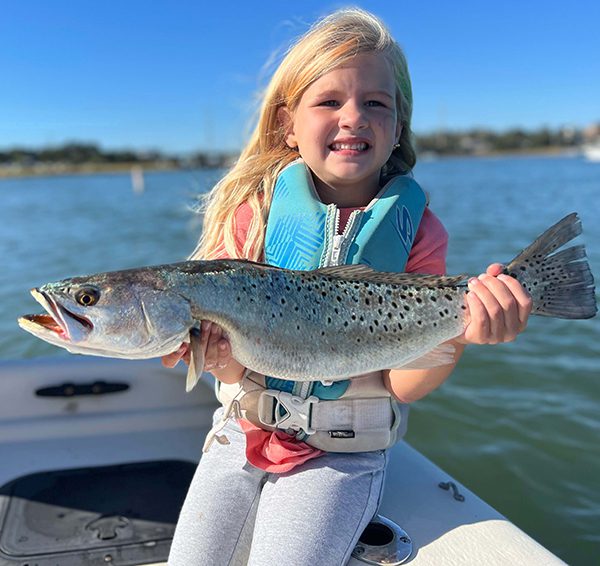Wrightsville Beach – December 2022
Tex, of Tex’s Tackle, reports that anglers are finding a bunch of speckled trout in the area. Sizes have been varied, from the smaller “spikes” to some large keepers all staged within close range of each other. A variety of MirrOlures, Vudu shrimp, D.O.A. shrimp, and live baits are producing strikes.
Bottom fishing with fresh baits has been producing black drum, some sheepshead, and the scattered red drum.
Surf anglers are having success while bottom fishing. There have been a lot of Virginia mullet and pufferfish running the beaches, and a mix of smaller bluefish, scattered trout, pompano, and the occasional red drum round out the surf catches.
Nearshore fishing in the 5-10 mile range has been producing bluefish, false albacore, king mackerel, and late-season spanish mackerel.
Getting out into the 10-30 mile range, anglers have focused more on bottom fishing, with catches of grouper and black sea bass.
Trolling over these structures has produced some kings.
Gulf stream anglers have been finding a good class of 30-60 lb. wahoo while pulling ballyhoo, and a few mahi have also been mixed in the action out at the break.

Lennon Clement (left) caught this 2.5 lb. speckled trout on live shrimp near the north end of Lea Island. She was fishing with her brother, Cash Clement.
Ryan, of Intracoastal Angler, reports that offshore anglers have been seeing good wahoo action while pulling both plugs and meat.
There have been tons of blackfin tuna around as well, and they’re hitting both skirted ballyhoo and plugs.
The middle range, from 15-30 miles, has been excellent for those looking to do some bottom fishing. Grouper and triggerfish are both feeding well in this range.
The king mackerel bite has pushed into this same area, and they’re striking both live and dead bait rigs.
Anglers running past the nearshore reefs are still seeing some very late schools of spanish mackerel, as well as bluefish. Both species can be caught with the classic Clarkspoon and planer setups. Anglers can expect the spanish mackerel, in particular, to disappear any day, though.
Inshore anglers are seeing the speckled trout bite starting to pick up with the cooler water temperatures. These groups of fish are being found anywhere from the surf zone back into the mainland creeks. There’s mostly a bunch of smaller trout around, but putting in time and moving around can produce some good-sized keepers. Most of the action has been from anglers fishing lightly weighted soft plastics, with both live shrimp and MirrOlures also having success.
Inshore anglers are also catching scattered red drum and black drum around the more structured areas and deeper holes.

Dan Kous, of Raleigh, caught this black drum using live shrimp on a Carolina rig in the Wrightsville Beach area. He was fishing with Capt. Zane Long of Falling Tide Fishing Adventures.
Luke, of Coastline Fishing Charters, reports that speckled have been staged up along the grass banks and in deep holes around the inlet. The bite has been very predictable, with fish actively feeding on each side of the tide. Baits like MR-17s, Vudu shrimp, and Z-Man Trout Tricks have all been solid options.
Red and black drum fishing has been great, and both improve moving into winter. The cooler water temperatures get these species to school up in tighter groups (and not spread out as they’ve been). Fishing Carolina-rigged shrimp and cut baits around docks or deeper oyster beds is a good tactic moving into winter.
The sheepshead fishing is going strong, and they’re feeding on live crabs or shrimp fished tight to inshore structure. Soon, though, these fish will be moving out to the nearshore wrecks to hang for the winter.
Anglers running out to the 2-5 mile range can expect to find grunts and keeper black sea bass to move in thick as cooler water temperatures prevail. Squid or cut baits on bottom or Carolina rigs will help put good numbers of fish into the boat.
Zane, of Falling Tide Fishing Adventures, reports that speckled trout fishing has been really good, with action being found just about everywhere in the creeks and inlet areas. Even topwater fishing has still been productive.
Red drum have mostly moved into their winter patterns where they school up and move into the creek and marsh areas.
Nearshore fishing has slowed down for most species. The outlier would be sheepshead which are now moving out onto rocks and structure off the beach. These fish will still feed best on live fiddler and mud crabs.
Rick, of Living Waters Guide Service, reports that temperatures in the Gulf Stream have finally started to come down some. This has helped ramp up the trolling bite on wahoo and really good numbers of blackfin tuna. A few sailfish are also mixed in the action.
It is also a great time to run out and fish jigs over deep water structure in the 150-400’ range for blackfin tuna and African pompano. This bite is a great option for anglers moving into winter and only gets better.
The swordfish action has been excellent this year, and there are no signs of things slowing down anytime soon. This is a great and under-utilized, year-round fishery in North Carolina.

Emery Harris (age 6), of Wilmington, hooked this 23″ speckled trout on a MirrOlure 17MR near Masonboro Island. She was fishing with her dad, Patrick Harris.
Ben, of Southern Run Fishing Charters, reports that grouper fishing action has remained hot for anglers running out to structure in the 60-70’+ range. Dead baits have been doing well in enticing a grouper bite.
King mackerel have started to show back up out in the 20-30 mile range. It has been key to target areas where that 70-degree water has pushed a little inshore, around areas such as the Cabbage Patch and 23 Mile Rock. Slow-trolling live baits and pulling Drone spoons and dead baits have all been effective.
The Gulf Stream wahoo action has started to pick up nicely, along with some great numbers of blackfin tuna in depths anywhere from 150-200’+. This action should only get better as nearshore waters cool and drive more wish to congregate on these warmer breaks.
Anglers looking to fish the nearshore wrecks can find some gray trout and bluefish by dropping smaller jigs (such as Big Nic Spanish Candies) around structure.
Patrick, of Johnnie Mercers Pier, reports that anglers have been catching a variety of species, from Virginia mullet, pompano, and puffers to spot and good-sized black drum (to 5 lbs.).
Fresh shrimp has been the top producing bait, with success also being had with sand fleas or Fishbites.





